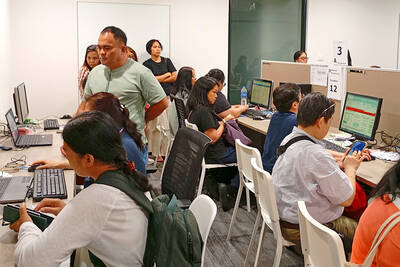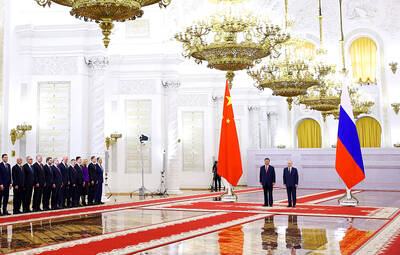Britain’s plan to send migrants and asylum seekers to Rwanda has left survivors of a similar scheme in Australia wondering why the “failed” policy that shattered their lives is being revived elsewhere.
For more than six years, Sudan-born refugee Abdul Aziz Muhamat was detained by Australian authorities in a small tropical island camp off Papua New Guinea’s mainland, hidden from full legal and public oversight.
“The simplest way to describe daily life on Manus Island is there’s no life,” Muhamat explained. “It’s worse than a prison. If you cry, no one will listen. If you shout, no one will come.”

Photo: EPA-EFE
Muhamat’s detention was part of Australia’s “Pacific Solution,” under which thousands of people who attempted to reach the country by boat were moved to offshore centers on Manus and the tiny nation of Nauru.
There, they were processed, given identification numbers and barred from ever permanently settling in Australia. Many languished in the camps for years, in conditions described by rights groups as “hellish.”
“They never could have got away with the conditions in those camps if they had been in Australia,” said Nick McKim, an Australian Greens Party senator who visited Manus five times before being refused entry.
“I have no hesitation in describing what happened in those camps as torture,” he said.
After vast taxpayer expense, 14 detainee deaths, a string of suicide attempts — some by detainees as young as five — and at least six referrals to the International Criminal Court, Australia’s scheme has been scaled back piece-by-piece. As of last month there were about 100 people still on Nauru.
Now the concept is being given new life by Britain, which plans to send asylum seekers to the land-locked African nation of Rwanda.
Iranian-born journalist Behrouz Boochani in 2013 was detained on Manus Island as he crossed from Indonesia during his flight from Iranian authorities, who considered him a dissident. He wrote a memoir about his time on Manus before receiving asylum in New Zealand.
Boochani urged the British public to resist plans “to copy the deeply dehumanizing asylum policies of Australia.”
However, British Prime Minister Boris Johnson — who has taken advice from a series of prominent Australian political strategists — has offered a familiar explanation for why it needs to go ahead: deterrence.
Like his Australian counterparts, Johnson said the policy will convince would-be migrants not to undertake perilous sea journeys on often rickety and overloaded vessels.
However, Australian legal expert Madeline Gleeson of the Kaldor Centre for International Refugee Law said data shows “definitively” that offshore detention did not deter asylum seekers.
Gleeson said the UK scheme most closely mirrors Australia’s policy between August 2012 and July 2013, when only some asylum seekers were sent to offshore camps.
“In that period, the number of people arriving by boat continued to rise to levels never before seen in Australia,” she said.
Muhamat, who attempted three times to reach Australia by boat from Indonesia, losing five of his closest friends en route, is more direct.
The policy “achieved nothing,” he said. “When you’re running to save your life. You don’t think about the tragedy you will encounter on your journey.”
“This is really one of the points that people don’t understand,” he added. “What option do people have? They have only one option; they will continue risking their life.”
Now living in Switzerland, Muhamat said the policy simply condemns people to a “failed” system — and tarnishes Britain’s status in the world.
“It will destroy the reputation of an entire country,” he said. “The image of the UK will be replaced with an image of human misery.”

A new online voting system aimed at boosting turnout among the Philippines’ millions of overseas workers ahead of Monday’s mid-term elections has been marked by confusion and fears of disenfranchisement. Thousands of overseas Filipino workers have already cast their ballots in the race dominated by a bitter feud between President Ferdinand Marcos Jr and his impeached vice president, Sara Duterte. While official turnout figures are not yet publicly available, data from the Philippine Commission on Elections (COMELEC) showed that at least 134,000 of the 1.22 million registered overseas voters have signed up for the new online system, which opened on April 13. However,

EUROPEAN FUTURE? Albanian Prime Minister Edi Rama says only he could secure EU membership, but challenges remain in dealing with corruption and a brain drain Albanian Prime Minister Edi Rama seeks to win an unprecedented fourth term, pledging to finally take the country into the EU and turn it into a hot tourist destination with some help from the Trump family. The artist-turned-politician has been pitching Albania as a trendy coastal destination, which has helped to drive up tourism arrivals to a record 11 million last year. US President Donald Trump’s son-in-law, Jared Kushner, also joined in the rush, pledging to invest US$1.4 billion to turn a largely deserted island into a luxurious getaway. Rama is expected to win another term after yesterday’s vote. The vote would

ALLIES: Calling Putin his ‘old friend,’ Xi said Beijing stood alongside Russia ‘in the face of the international counter-current of unilateralism and hegemonic bullying’ Chinese President Xi Jinping (習近平) yesterday was in Moscow for a state visit ahead of the Kremlin’s grand Victory Day celebrations, as Ukraine accused Russia’s army of launching air strikes just hours into a supposed truce. More than 20 foreign leaders were in Russia to attend a vast military parade today marking 80 years since the defeat of Nazi Germany in World War II, taking place three years into Russia’s offensive in Ukraine. Putin ordered troops into Ukraine in February 2022 and has marshaled the memory of Soviet victory against Nazi Germany to justify his campaign and rally society behind the offensive,

CONFLICTING REPORTS: Beijing said it was ‘not familiar with the matter’ when asked if Chinese jets were used in the conflict, after Pakistan’s foreign minister said they were The Pakistan Army yesterday said it shot down 25 Indian drones, a day after the worst violence between the nuclear-armed rivals in two decades. Pakistani Prime Minister Shehbaz Sharif vowed to retaliate after India launched deadly missile strikes on Wednesday morning, escalating days of gunfire along their border. At least 45 deaths were reported from both sides following Wednesday’s violence, including children. Pakistan’s military said in a statement yesterday that it had “so far shot down 25 Israeli-made Harop drones” at multiple location across the country. “Last night, India showed another act of aggression by sending drones to multiple locations,” Pakistan military spokesman Ahmed